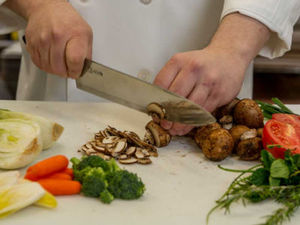 "
"
Tucked far on the perimeter of campus, past the Federal Credit Union and St. Michael’s Laundry, stands an innocuous building with a pale brown sign reading, “The Center for Culinary Excellence.” Formerly the Food Services Support Facility, the CCE houses a new catering kitchen — which was located in North Dining Hall from 1998-2014 — along with a cook and chill operation, a bakery, a protein shop, a spacious pantry and the preparation space for Grab ‘n Go.
So what exactly is the Center for Culinary Excellence?
Instead of being delivered to a central storage area as in the past, food prepared here can be delivered directly to campus units. The CCE separates catering and student dining in order to improve food quality and freshness. This is partially accomplished by using locally sourced food, defined by the university as food from Indiana and Michigan or within 250 miles of campus. This includes Ohio, Illinois and Wisconsin.
The Center also works to connect Notre Dame with vendors. “Whenever possible, we try to get a higher quality product for a comparable price with ties to Notre Dame,” Chris Abayasinghe, director of food services, says.
For example, Notre Dame’s standard wine is William Hill, owned by a Notre Dame alum. But the Center also tries to help small growers.
“We want to figure out a way for farms to bring their products to market,” Abayasinghe says. “That process is still in its infancy, but we have moved from warehouse production to a culinary facility.”
Abayasinghe talks about trying to “close the loop.” From growing and purchasing and cooking, all the way down to recycling and disposal, the university wants to create as little waste as possible. For example, the staff uses herbs grown in the campus community garden instead of dried herbs as much as possible, as well as using a single-stream recycling facility, and they will soon begin composting.
Not only has the CCE helped change sourcing, but the facility has also evolved along with production. The addition of a separate space for Catering, housed outside of North Dining Hall, has led to important improvements.
“Catering is designed to be high volume with high quality,” Giuseppe Macerata, culinary production manager, says. “Dining hall staff can now focus on student dining and catering can focus on guests.”
Students are also welcome at the facility, both in a culinary capacity and for learning the business side of operations.
“We want students to come over here and work,” Macerata says. “The staff take care of you here and they’ll send you home with goodies.”
The sense of family and community is palpable as you walk through the Center. In the pastry shop, it’s things like Laura Johnson-Lachowecki packing cookies and cupcakes to take home, modestly beaming as John Glon, general manager of the Food Service Support Facility, mentions that she won the American Culinary Federation’s Pastry Chef of the Year Award. In the protein shop, it’s Doris Housand hand-pulling herbs for marinades while talking about her inspiration to go home and use the same ingredients in her own cooking.
So when December rolls around and you find yourself munching on Christmas cookies, spare a thought for the staff responsible for baking and decorating the 1.2 million cookies that bring the Christmas spirit to your day. They’re the same people responsible for preparing 900 graduation cakes each year so every graduate who wants a cake can have his or her own. They prepare and package your Grab ‘n Go meals so you can still have a nice meal even on your busiest days. The CCE staff are the barely seen and too rarely thanked individuals making sure each meal and event is the best it can be.
If you are interested in working with the CCE, email Giuseppe Macerata at gmacerat@nd.edu.